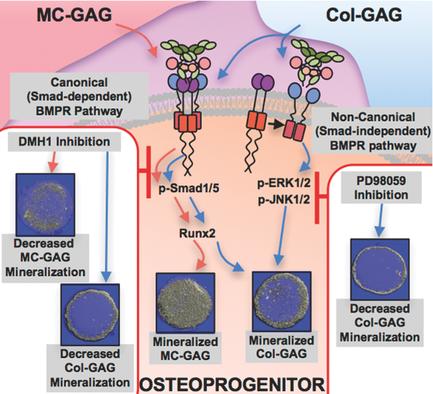当前位置:
X-MOL 学术
›
Adv. Healthcare Mater.
›
论文详情
Our official English website, www.x-mol.net, welcomes your feedback! (Note: you will need to create a separate account there.)
Nonmineralized and Mineralized Collagen Scaffolds Induce Differential Osteogenic Signaling Pathways in Human Mesenchymal Stem Cells
Advanced Healthcare Materials ( IF 10.0 ) Pub Date : 2017-09-25 , DOI: 10.1002/adhm.201700641 Qi Zhou 1, 2, 3 , Xiaoyan Ren 1, 2 , David Bischoff 2 , Daniel W. Weisgerber 4 , Dean T. Yamaguchi 2 , Timothy A. Miller 1, 2 , Brendan A. C. Harley 4 , Justine C. Lee 1, 2
Advanced Healthcare Materials ( IF 10.0 ) Pub Date : 2017-09-25 , DOI: 10.1002/adhm.201700641 Qi Zhou 1, 2, 3 , Xiaoyan Ren 1, 2 , David Bischoff 2 , Daniel W. Weisgerber 4 , Dean T. Yamaguchi 2 , Timothy A. Miller 1, 2 , Brendan A. C. Harley 4 , Justine C. Lee 1, 2
Affiliation

|
The instructive capabilities of extracellular matrix components in progenitor cell differentiation have recently generated significant interest in the development of bioinspired materials for regenerative applications. Previously, a correlation was described between the osteogenic capabilities of nanoparticulate mineralized collagen glycosaminoglycan scaffolds (MC‐GAG) and an autogenous activation of small mothers against decapentaplegic ( Smad1/5) in the canonical bone morphogenetic protein receptor (BMPR) pathway with a diminished extracellular signal regulated kinase 1/2 (ERK1/2) activation when compared to nonmineralized collagen glycosaminoglycan scaffolds (Col‐GAG). This work utilizes a canonical BMPR inhibitor (dorsomorphin homologue 1, DMH1) and an inhibitor of the mitogen activated protein kinase/ERK kinase (MEK)/(ERK) cascade (PD98059) to characterize the necessity of each pathway for osteogenesis. While DMH1 inhibits runt‐related transcription factor 2 (Runx2) and bone sialoprotein II (BSPII) gene expression of primary human mesenchymal stem cells (hMSCs) on MC‐GAG, PD98059 inhibits BSPII expression on Col‐GAG independent of Runx2 expression. DMH1 inhibits mineralization on both Col‐GAG and MC‐GAG, however, PD98059 only inhibits mineralization on Col‐GAG. DMH1 inhibits both Smad1/5 phosphorylation and Runx2 protein expression, whereas PD98059 inhibits ERK1/2 and c‐Jun amino‐terminal kinase 1/2 (JNK1/2) phosphorylation without affecting Runx2. Thus, activation of the canonical BMPR signaling is necessary for osteogenic differentiation and mineralization of hMSCs on Col‐GAG or MC‐GAG. The MEK/ERK cascade, intimately tied to JNK activation, is necessary for Runx2‐independent osteogenesis on Col‐GAG, while completely dispensable in osteogenesis on MC‐GAG.
中文翻译:

非矿化和矿化的胶原蛋白支架在人间充质干细胞中诱导差异性成骨信号通路。
细胞外基质成分在祖细胞分化中的指导能力最近引起了人们对用于再生应用的生物启发性材料的开发的极大兴趣。以前,描述了矿物质化胶原蛋白糖胺聚糖纳米颗粒支架(MC-GAG)的成骨能力与小母亲针对去甲肾上腺素能(Smad1 / 5)的自发激活之间的相关性,其中经典的骨形态发生蛋白受体(BMPR)途径细胞外细胞减少与非矿化胶原糖胺聚糖支架(Col-GAG)相比,信号调节激酶1/2(ERK1 / 2)活化。这项工作采用了规范的BMPR抑制剂(dorsomorphin的同系物1,DMH1)和促分裂原活化蛋白激酶/ ERK激酶(MEK)/(ERK)级联抑制剂(PD98059),以表征每种成骨途径的必要性。虽然DMH1抑制MC‐GAG上的人间充质干细胞(hMSC)的矮小相关转录因子2(Runx2)和骨唾液蛋白II(BSPII)基因表达,但PD98059不受ColxGA表达的影响而抑制Col‐GAG上的BSPII表达。DMH1抑制Col-GAG和MC-GAG上的矿化作用,但是,PD98059仅抑制Col-GAG上的矿化作用。DMH1抑制Smad1 / 5磷酸化和Runx2蛋白表达,而PD98059抑制ERK1 / 2和c-Jun氨基末端激酶1/2(JNK1 / 2)磷酸化,而不影响Runx2。因此,规范BMPR信号的激活对于Col-GAG或MC-GAG上hMSC的成骨分化和矿化是必需的。MEK / ERK级联与JNK激活密切相关,对于Col-GAG上不依赖Runx2的成骨作用是必需的,而对于MC-GAG上的成骨作用则是完全不需要的。
更新日期:2017-09-25
中文翻译:

非矿化和矿化的胶原蛋白支架在人间充质干细胞中诱导差异性成骨信号通路。
细胞外基质成分在祖细胞分化中的指导能力最近引起了人们对用于再生应用的生物启发性材料的开发的极大兴趣。以前,描述了矿物质化胶原蛋白糖胺聚糖纳米颗粒支架(MC-GAG)的成骨能力与小母亲针对去甲肾上腺素能(Smad1 / 5)的自发激活之间的相关性,其中经典的骨形态发生蛋白受体(BMPR)途径细胞外细胞减少与非矿化胶原糖胺聚糖支架(Col-GAG)相比,信号调节激酶1/2(ERK1 / 2)活化。这项工作采用了规范的BMPR抑制剂(dorsomorphin的同系物1,DMH1)和促分裂原活化蛋白激酶/ ERK激酶(MEK)/(ERK)级联抑制剂(PD98059),以表征每种成骨途径的必要性。虽然DMH1抑制MC‐GAG上的人间充质干细胞(hMSC)的矮小相关转录因子2(Runx2)和骨唾液蛋白II(BSPII)基因表达,但PD98059不受ColxGA表达的影响而抑制Col‐GAG上的BSPII表达。DMH1抑制Col-GAG和MC-GAG上的矿化作用,但是,PD98059仅抑制Col-GAG上的矿化作用。DMH1抑制Smad1 / 5磷酸化和Runx2蛋白表达,而PD98059抑制ERK1 / 2和c-Jun氨基末端激酶1/2(JNK1 / 2)磷酸化,而不影响Runx2。因此,规范BMPR信号的激活对于Col-GAG或MC-GAG上hMSC的成骨分化和矿化是必需的。MEK / ERK级联与JNK激活密切相关,对于Col-GAG上不依赖Runx2的成骨作用是必需的,而对于MC-GAG上的成骨作用则是完全不需要的。



























 京公网安备 11010802027423号
京公网安备 11010802027423号